Auditing and Control in the Organization: Case Study and Analysis
VerifiedAdded on 2023/01/04
|22
|6874
|125
Case Study
AI Summary
This case study examines auditing and control in organizational settings, focusing on the analysis of various scenarios and the determination of appropriate audit opinions. The first part of the study analyzes six different situations, recommending whether a qualified or adverse audit opinion is necessary, and provides justifications for each recommendation based on the presence of material misstatements and non-compliance with accounting standards. The second part of the study identifies and explains weaknesses in the internal control systems of Big Office Company, providing reasoned arguments for why these elements represent vulnerabilities. The report covers topics like allowance for doubtful debts, inventory valuation, going concern, and fair value accounting, demonstrating the importance of internal controls and their impact on financial reporting.
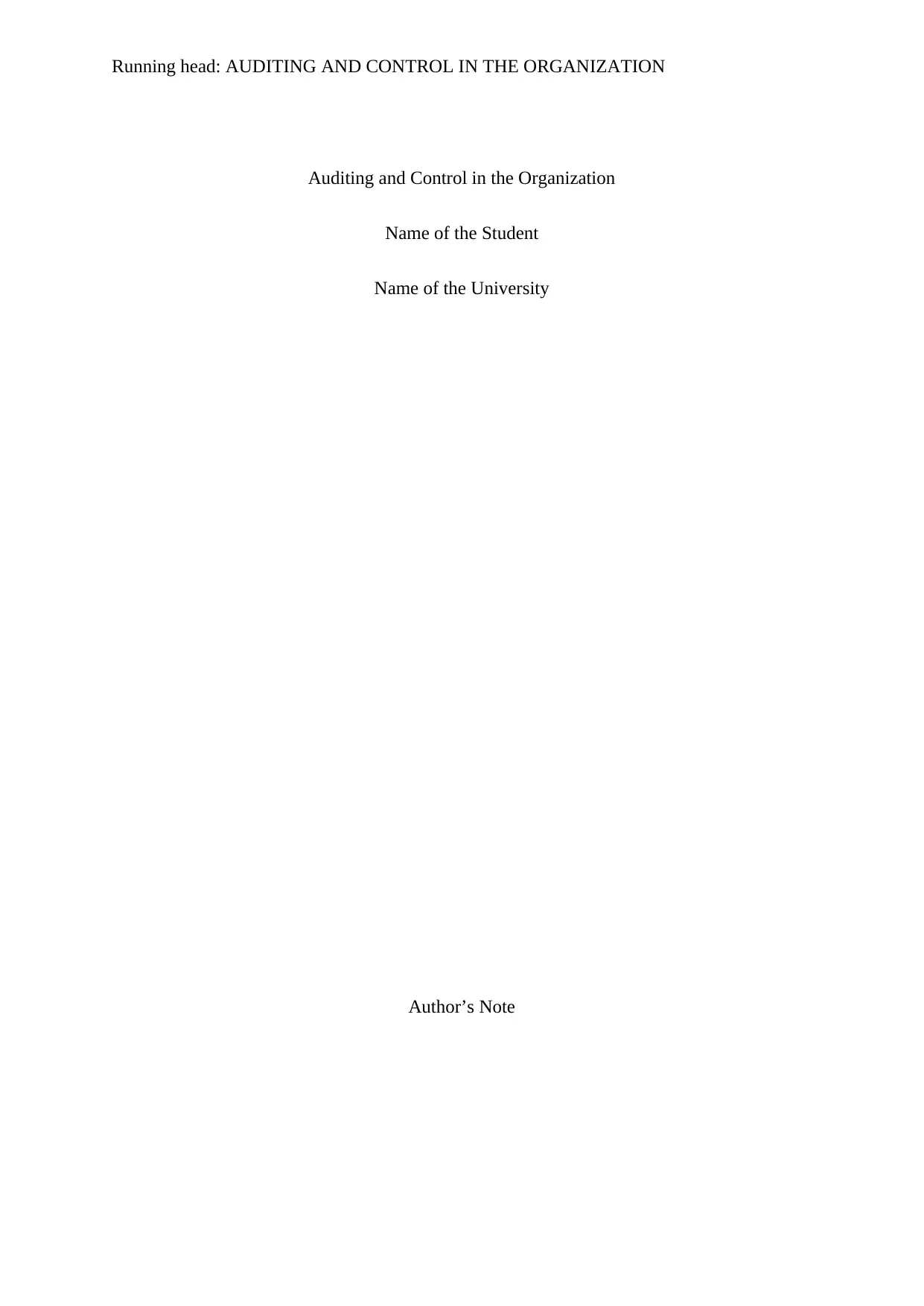
Running head: AUDITING AND CONTROL IN THE ORGANIZATION
Auditing and Control in the Organization
Name of the Student
Name of the University
Author’s Note
Auditing and Control in the Organization
Name of the Student
Name of the University
Author’s Note
Paraphrase This Document
Need a fresh take? Get an instant paraphrase of this document with our AI Paraphraser
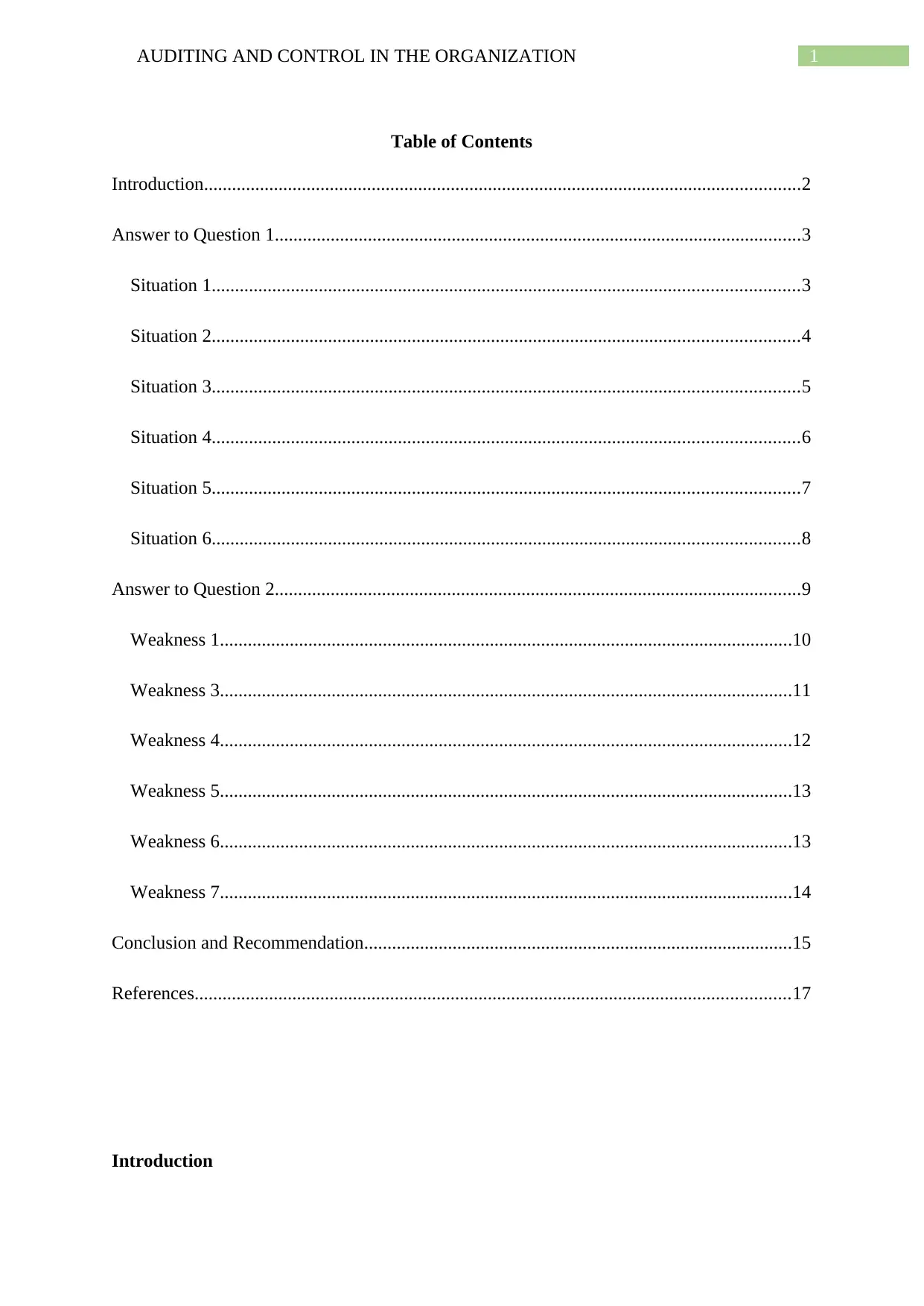
1AUDITING AND CONTROL IN THE ORGANIZATION
Table of Contents
Introduction................................................................................................................................2
Answer to Question 1.................................................................................................................3
Situation 1..............................................................................................................................3
Situation 2..............................................................................................................................4
Situation 3..............................................................................................................................5
Situation 4..............................................................................................................................6
Situation 5..............................................................................................................................7
Situation 6..............................................................................................................................8
Answer to Question 2.................................................................................................................9
Weakness 1...........................................................................................................................10
Weakness 3...........................................................................................................................11
Weakness 4...........................................................................................................................12
Weakness 5...........................................................................................................................13
Weakness 6...........................................................................................................................13
Weakness 7...........................................................................................................................14
Conclusion and Recommendation............................................................................................15
References................................................................................................................................17
Introduction
Table of Contents
Introduction................................................................................................................................2
Answer to Question 1.................................................................................................................3
Situation 1..............................................................................................................................3
Situation 2..............................................................................................................................4
Situation 3..............................................................................................................................5
Situation 4..............................................................................................................................6
Situation 5..............................................................................................................................7
Situation 6..............................................................................................................................8
Answer to Question 2.................................................................................................................9
Weakness 1...........................................................................................................................10
Weakness 3...........................................................................................................................11
Weakness 4...........................................................................................................................12
Weakness 5...........................................................................................................................13
Weakness 6...........................................................................................................................13
Weakness 7...........................................................................................................................14
Conclusion and Recommendation............................................................................................15
References................................................................................................................................17
Introduction
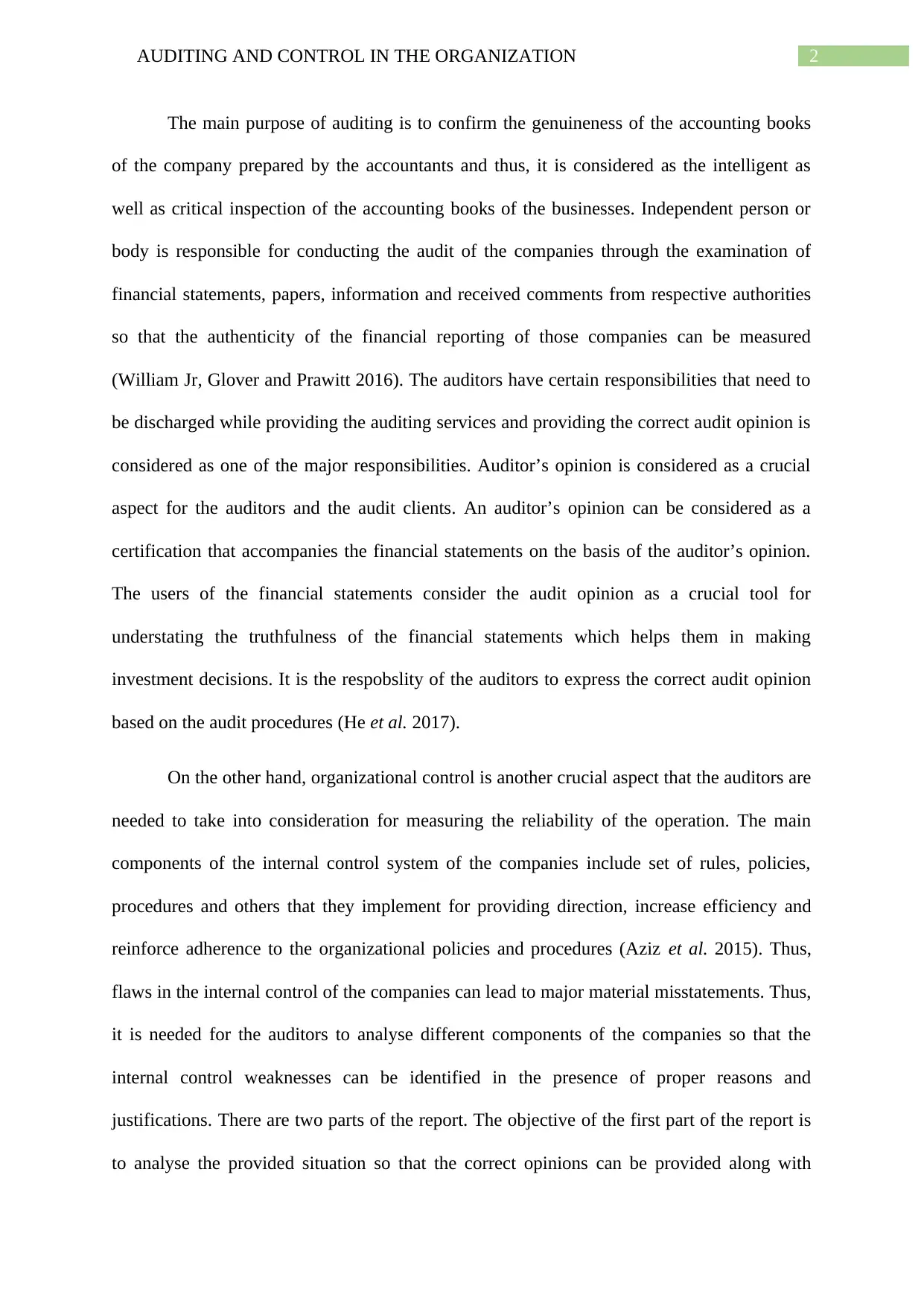
2AUDITING AND CONTROL IN THE ORGANIZATION
The main purpose of auditing is to confirm the genuineness of the accounting books
of the company prepared by the accountants and thus, it is considered as the intelligent as
well as critical inspection of the accounting books of the businesses. Independent person or
body is responsible for conducting the audit of the companies through the examination of
financial statements, papers, information and received comments from respective authorities
so that the authenticity of the financial reporting of those companies can be measured
(William Jr, Glover and Prawitt 2016). The auditors have certain responsibilities that need to
be discharged while providing the auditing services and providing the correct audit opinion is
considered as one of the major responsibilities. Auditor’s opinion is considered as a crucial
aspect for the auditors and the audit clients. An auditor’s opinion can be considered as a
certification that accompanies the financial statements on the basis of the auditor’s opinion.
The users of the financial statements consider the audit opinion as a crucial tool for
understating the truthfulness of the financial statements which helps them in making
investment decisions. It is the respobslity of the auditors to express the correct audit opinion
based on the audit procedures (He et al. 2017).
On the other hand, organizational control is another crucial aspect that the auditors are
needed to take into consideration for measuring the reliability of the operation. The main
components of the internal control system of the companies include set of rules, policies,
procedures and others that they implement for providing direction, increase efficiency and
reinforce adherence to the organizational policies and procedures (Aziz et al. 2015). Thus,
flaws in the internal control of the companies can lead to major material misstatements. Thus,
it is needed for the auditors to analyse different components of the companies so that the
internal control weaknesses can be identified in the presence of proper reasons and
justifications. There are two parts of the report. The objective of the first part of the report is
to analyse the provided situation so that the correct opinions can be provided along with
The main purpose of auditing is to confirm the genuineness of the accounting books
of the company prepared by the accountants and thus, it is considered as the intelligent as
well as critical inspection of the accounting books of the businesses. Independent person or
body is responsible for conducting the audit of the companies through the examination of
financial statements, papers, information and received comments from respective authorities
so that the authenticity of the financial reporting of those companies can be measured
(William Jr, Glover and Prawitt 2016). The auditors have certain responsibilities that need to
be discharged while providing the auditing services and providing the correct audit opinion is
considered as one of the major responsibilities. Auditor’s opinion is considered as a crucial
aspect for the auditors and the audit clients. An auditor’s opinion can be considered as a
certification that accompanies the financial statements on the basis of the auditor’s opinion.
The users of the financial statements consider the audit opinion as a crucial tool for
understating the truthfulness of the financial statements which helps them in making
investment decisions. It is the respobslity of the auditors to express the correct audit opinion
based on the audit procedures (He et al. 2017).
On the other hand, organizational control is another crucial aspect that the auditors are
needed to take into consideration for measuring the reliability of the operation. The main
components of the internal control system of the companies include set of rules, policies,
procedures and others that they implement for providing direction, increase efficiency and
reinforce adherence to the organizational policies and procedures (Aziz et al. 2015). Thus,
flaws in the internal control of the companies can lead to major material misstatements. Thus,
it is needed for the auditors to analyse different components of the companies so that the
internal control weaknesses can be identified in the presence of proper reasons and
justifications. There are two parts of the report. The objective of the first part of the report is
to analyse the provided situation so that the correct opinions can be provided along with
⊘ This is a preview!⊘
Do you want full access?
Subscribe today to unlock all pages.

Trusted by 1+ million students worldwide
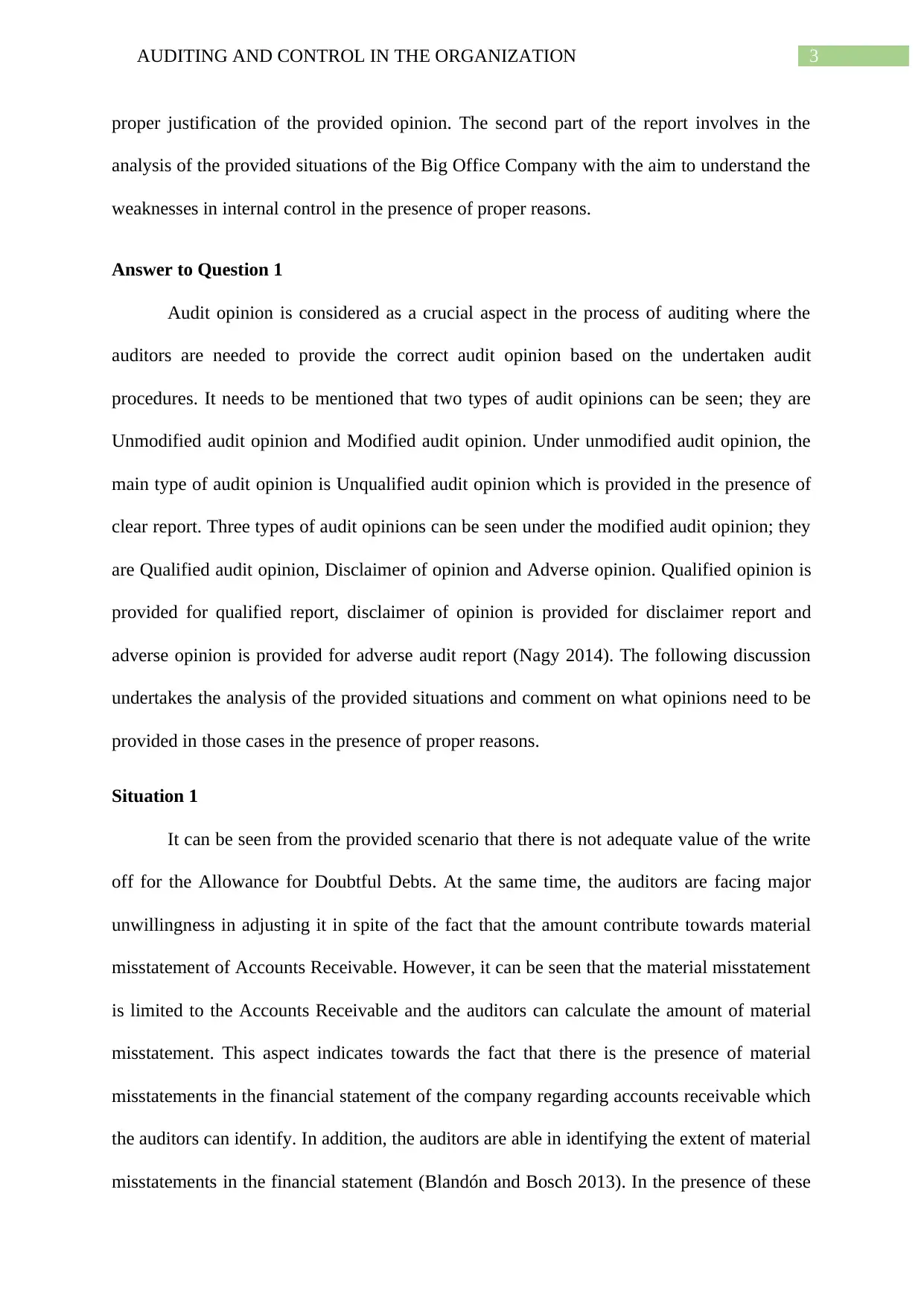
3AUDITING AND CONTROL IN THE ORGANIZATION
proper justification of the provided opinion. The second part of the report involves in the
analysis of the provided situations of the Big Office Company with the aim to understand the
weaknesses in internal control in the presence of proper reasons.
Answer to Question 1
Audit opinion is considered as a crucial aspect in the process of auditing where the
auditors are needed to provide the correct audit opinion based on the undertaken audit
procedures. It needs to be mentioned that two types of audit opinions can be seen; they are
Unmodified audit opinion and Modified audit opinion. Under unmodified audit opinion, the
main type of audit opinion is Unqualified audit opinion which is provided in the presence of
clear report. Three types of audit opinions can be seen under the modified audit opinion; they
are Qualified audit opinion, Disclaimer of opinion and Adverse opinion. Qualified opinion is
provided for qualified report, disclaimer of opinion is provided for disclaimer report and
adverse opinion is provided for adverse audit report (Nagy 2014). The following discussion
undertakes the analysis of the provided situations and comment on what opinions need to be
provided in those cases in the presence of proper reasons.
Situation 1
It can be seen from the provided scenario that there is not adequate value of the write
off for the Allowance for Doubtful Debts. At the same time, the auditors are facing major
unwillingness in adjusting it in spite of the fact that the amount contribute towards material
misstatement of Accounts Receivable. However, it can be seen that the material misstatement
is limited to the Accounts Receivable and the auditors can calculate the amount of material
misstatement. This aspect indicates towards the fact that there is the presence of material
misstatements in the financial statement of the company regarding accounts receivable which
the auditors can identify. In addition, the auditors are able in identifying the extent of material
misstatements in the financial statement (Blandón and Bosch 2013). In the presence of these
proper justification of the provided opinion. The second part of the report involves in the
analysis of the provided situations of the Big Office Company with the aim to understand the
weaknesses in internal control in the presence of proper reasons.
Answer to Question 1
Audit opinion is considered as a crucial aspect in the process of auditing where the
auditors are needed to provide the correct audit opinion based on the undertaken audit
procedures. It needs to be mentioned that two types of audit opinions can be seen; they are
Unmodified audit opinion and Modified audit opinion. Under unmodified audit opinion, the
main type of audit opinion is Unqualified audit opinion which is provided in the presence of
clear report. Three types of audit opinions can be seen under the modified audit opinion; they
are Qualified audit opinion, Disclaimer of opinion and Adverse opinion. Qualified opinion is
provided for qualified report, disclaimer of opinion is provided for disclaimer report and
adverse opinion is provided for adverse audit report (Nagy 2014). The following discussion
undertakes the analysis of the provided situations and comment on what opinions need to be
provided in those cases in the presence of proper reasons.
Situation 1
It can be seen from the provided scenario that there is not adequate value of the write
off for the Allowance for Doubtful Debts. At the same time, the auditors are facing major
unwillingness in adjusting it in spite of the fact that the amount contribute towards material
misstatement of Accounts Receivable. However, it can be seen that the material misstatement
is limited to the Accounts Receivable and the auditors can calculate the amount of material
misstatement. This aspect indicates towards the fact that there is the presence of material
misstatements in the financial statement of the company regarding accounts receivable which
the auditors can identify. In addition, the auditors are able in identifying the extent of material
misstatements in the financial statement (Blandón and Bosch 2013). In the presence of these
Paraphrase This Document
Need a fresh take? Get an instant paraphrase of this document with our AI Paraphraser
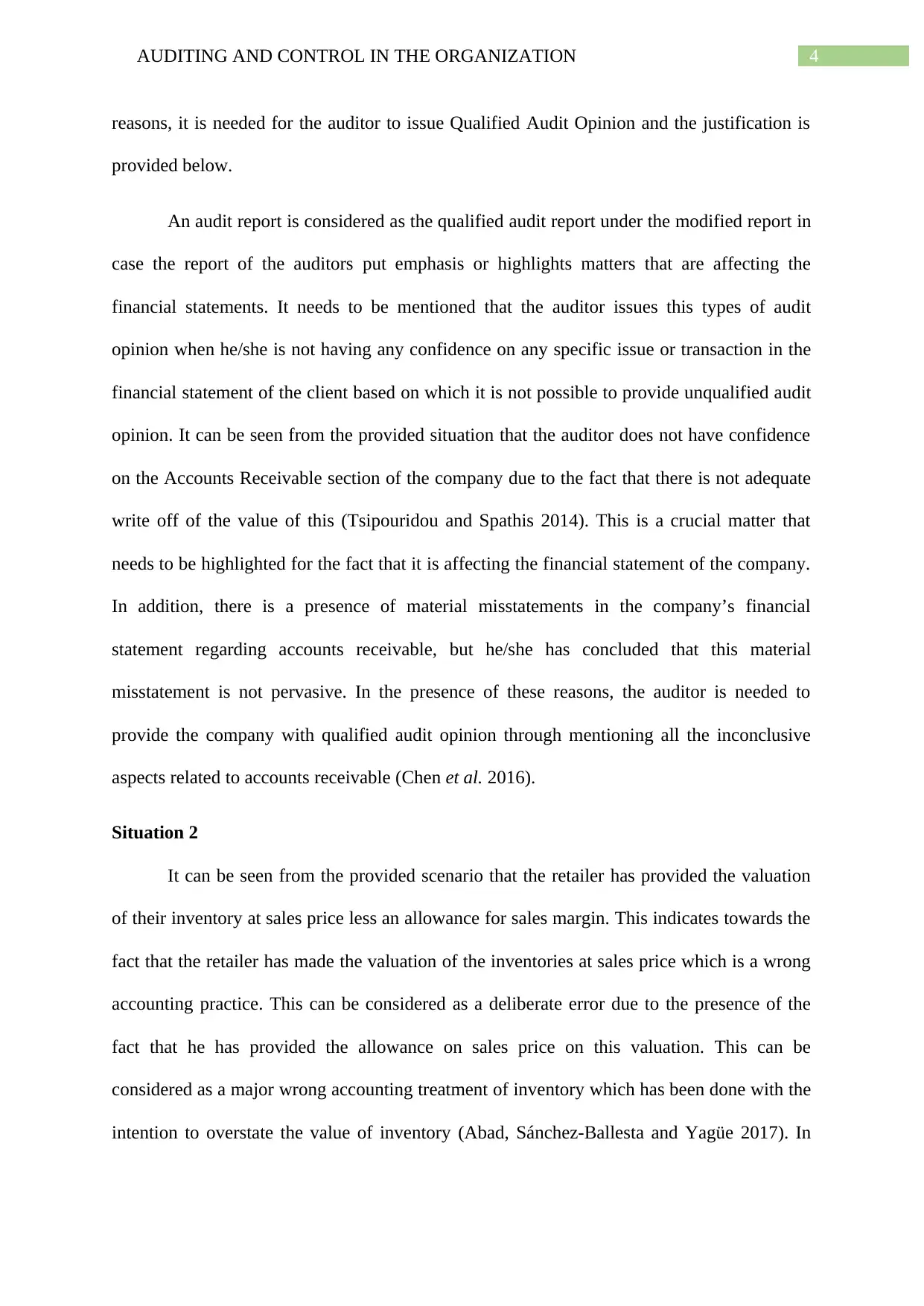
4AUDITING AND CONTROL IN THE ORGANIZATION
reasons, it is needed for the auditor to issue Qualified Audit Opinion and the justification is
provided below.
An audit report is considered as the qualified audit report under the modified report in
case the report of the auditors put emphasis or highlights matters that are affecting the
financial statements. It needs to be mentioned that the auditor issues this types of audit
opinion when he/she is not having any confidence on any specific issue or transaction in the
financial statement of the client based on which it is not possible to provide unqualified audit
opinion. It can be seen from the provided situation that the auditor does not have confidence
on the Accounts Receivable section of the company due to the fact that there is not adequate
write off of the value of this (Tsipouridou and Spathis 2014). This is a crucial matter that
needs to be highlighted for the fact that it is affecting the financial statement of the company.
In addition, there is a presence of material misstatements in the company’s financial
statement regarding accounts receivable, but he/she has concluded that this material
misstatement is not pervasive. In the presence of these reasons, the auditor is needed to
provide the company with qualified audit opinion through mentioning all the inconclusive
aspects related to accounts receivable (Chen et al. 2016).
Situation 2
It can be seen from the provided scenario that the retailer has provided the valuation
of their inventory at sales price less an allowance for sales margin. This indicates towards the
fact that the retailer has made the valuation of the inventories at sales price which is a wrong
accounting practice. This can be considered as a deliberate error due to the presence of the
fact that he has provided the allowance on sales price on this valuation. This can be
considered as a major wrong accounting treatment of inventory which has been done with the
intention to overstate the value of inventory (Abad, Sánchez‐Ballesta and Yagüe 2017). In
reasons, it is needed for the auditor to issue Qualified Audit Opinion and the justification is
provided below.
An audit report is considered as the qualified audit report under the modified report in
case the report of the auditors put emphasis or highlights matters that are affecting the
financial statements. It needs to be mentioned that the auditor issues this types of audit
opinion when he/she is not having any confidence on any specific issue or transaction in the
financial statement of the client based on which it is not possible to provide unqualified audit
opinion. It can be seen from the provided situation that the auditor does not have confidence
on the Accounts Receivable section of the company due to the fact that there is not adequate
write off of the value of this (Tsipouridou and Spathis 2014). This is a crucial matter that
needs to be highlighted for the fact that it is affecting the financial statement of the company.
In addition, there is a presence of material misstatements in the company’s financial
statement regarding accounts receivable, but he/she has concluded that this material
misstatement is not pervasive. In the presence of these reasons, the auditor is needed to
provide the company with qualified audit opinion through mentioning all the inconclusive
aspects related to accounts receivable (Chen et al. 2016).
Situation 2
It can be seen from the provided scenario that the retailer has provided the valuation
of their inventory at sales price less an allowance for sales margin. This indicates towards the
fact that the retailer has made the valuation of the inventories at sales price which is a wrong
accounting practice. This can be considered as a deliberate error due to the presence of the
fact that he has provided the allowance on sales price on this valuation. This can be
considered as a major wrong accounting treatment of inventory which has been done with the
intention to overstate the value of inventory (Abad, Sánchez‐Ballesta and Yagüe 2017). In
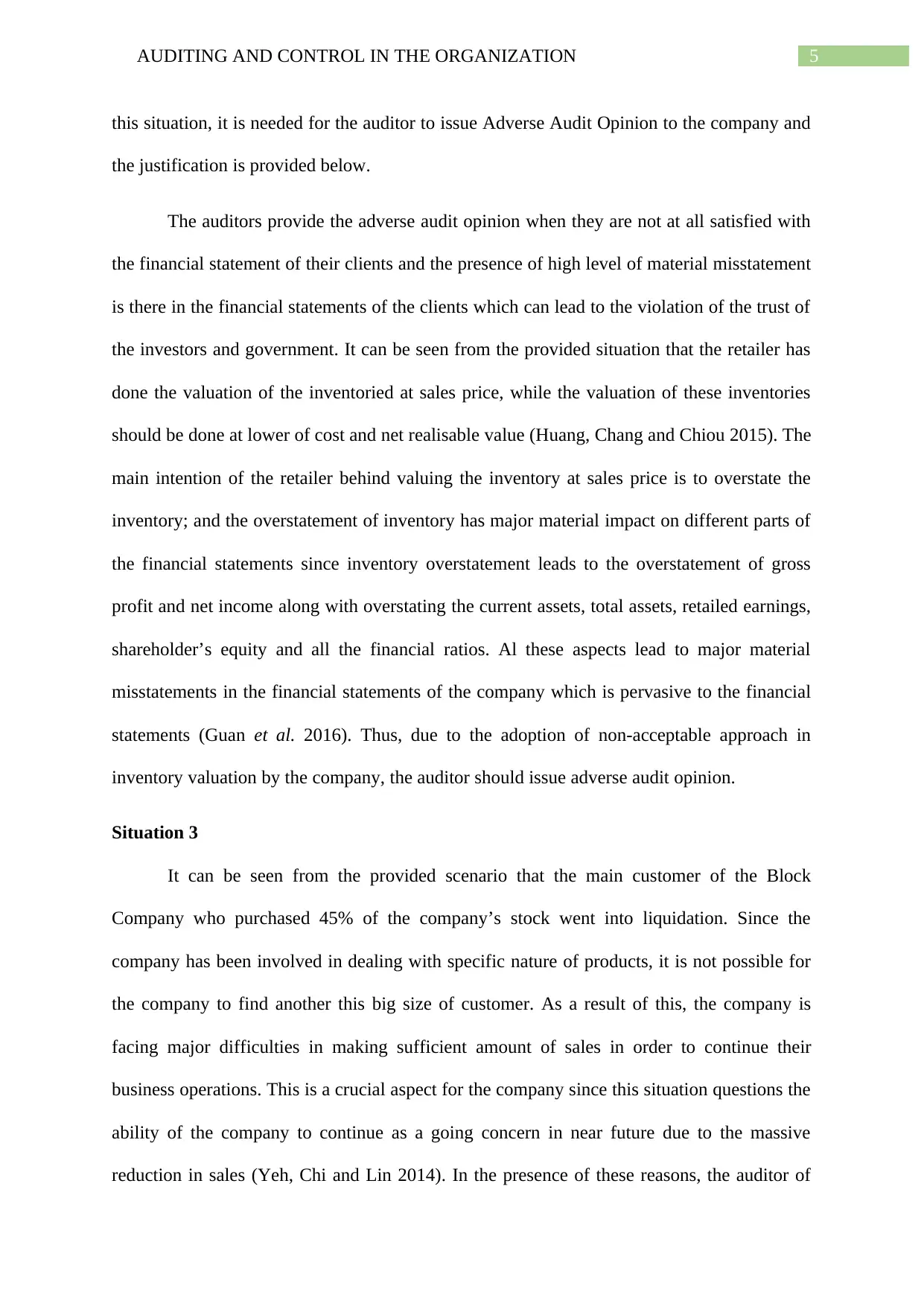
5AUDITING AND CONTROL IN THE ORGANIZATION
this situation, it is needed for the auditor to issue Adverse Audit Opinion to the company and
the justification is provided below.
The auditors provide the adverse audit opinion when they are not at all satisfied with
the financial statement of their clients and the presence of high level of material misstatement
is there in the financial statements of the clients which can lead to the violation of the trust of
the investors and government. It can be seen from the provided situation that the retailer has
done the valuation of the inventoried at sales price, while the valuation of these inventories
should be done at lower of cost and net realisable value (Huang, Chang and Chiou 2015). The
main intention of the retailer behind valuing the inventory at sales price is to overstate the
inventory; and the overstatement of inventory has major material impact on different parts of
the financial statements since inventory overstatement leads to the overstatement of gross
profit and net income along with overstating the current assets, total assets, retailed earnings,
shareholder’s equity and all the financial ratios. Al these aspects lead to major material
misstatements in the financial statements of the company which is pervasive to the financial
statements (Guan et al. 2016). Thus, due to the adoption of non-acceptable approach in
inventory valuation by the company, the auditor should issue adverse audit opinion.
Situation 3
It can be seen from the provided scenario that the main customer of the Block
Company who purchased 45% of the company’s stock went into liquidation. Since the
company has been involved in dealing with specific nature of products, it is not possible for
the company to find another this big size of customer. As a result of this, the company is
facing major difficulties in making sufficient amount of sales in order to continue their
business operations. This is a crucial aspect for the company since this situation questions the
ability of the company to continue as a going concern in near future due to the massive
reduction in sales (Yeh, Chi and Lin 2014). In the presence of these reasons, the auditor of
this situation, it is needed for the auditor to issue Adverse Audit Opinion to the company and
the justification is provided below.
The auditors provide the adverse audit opinion when they are not at all satisfied with
the financial statement of their clients and the presence of high level of material misstatement
is there in the financial statements of the clients which can lead to the violation of the trust of
the investors and government. It can be seen from the provided situation that the retailer has
done the valuation of the inventoried at sales price, while the valuation of these inventories
should be done at lower of cost and net realisable value (Huang, Chang and Chiou 2015). The
main intention of the retailer behind valuing the inventory at sales price is to overstate the
inventory; and the overstatement of inventory has major material impact on different parts of
the financial statements since inventory overstatement leads to the overstatement of gross
profit and net income along with overstating the current assets, total assets, retailed earnings,
shareholder’s equity and all the financial ratios. Al these aspects lead to major material
misstatements in the financial statements of the company which is pervasive to the financial
statements (Guan et al. 2016). Thus, due to the adoption of non-acceptable approach in
inventory valuation by the company, the auditor should issue adverse audit opinion.
Situation 3
It can be seen from the provided scenario that the main customer of the Block
Company who purchased 45% of the company’s stock went into liquidation. Since the
company has been involved in dealing with specific nature of products, it is not possible for
the company to find another this big size of customer. As a result of this, the company is
facing major difficulties in making sufficient amount of sales in order to continue their
business operations. This is a crucial aspect for the company since this situation questions the
ability of the company to continue as a going concern in near future due to the massive
reduction in sales (Yeh, Chi and Lin 2014). In the presence of these reasons, the auditor of
⊘ This is a preview!⊘
Do you want full access?
Subscribe today to unlock all pages.

Trusted by 1+ million students worldwide
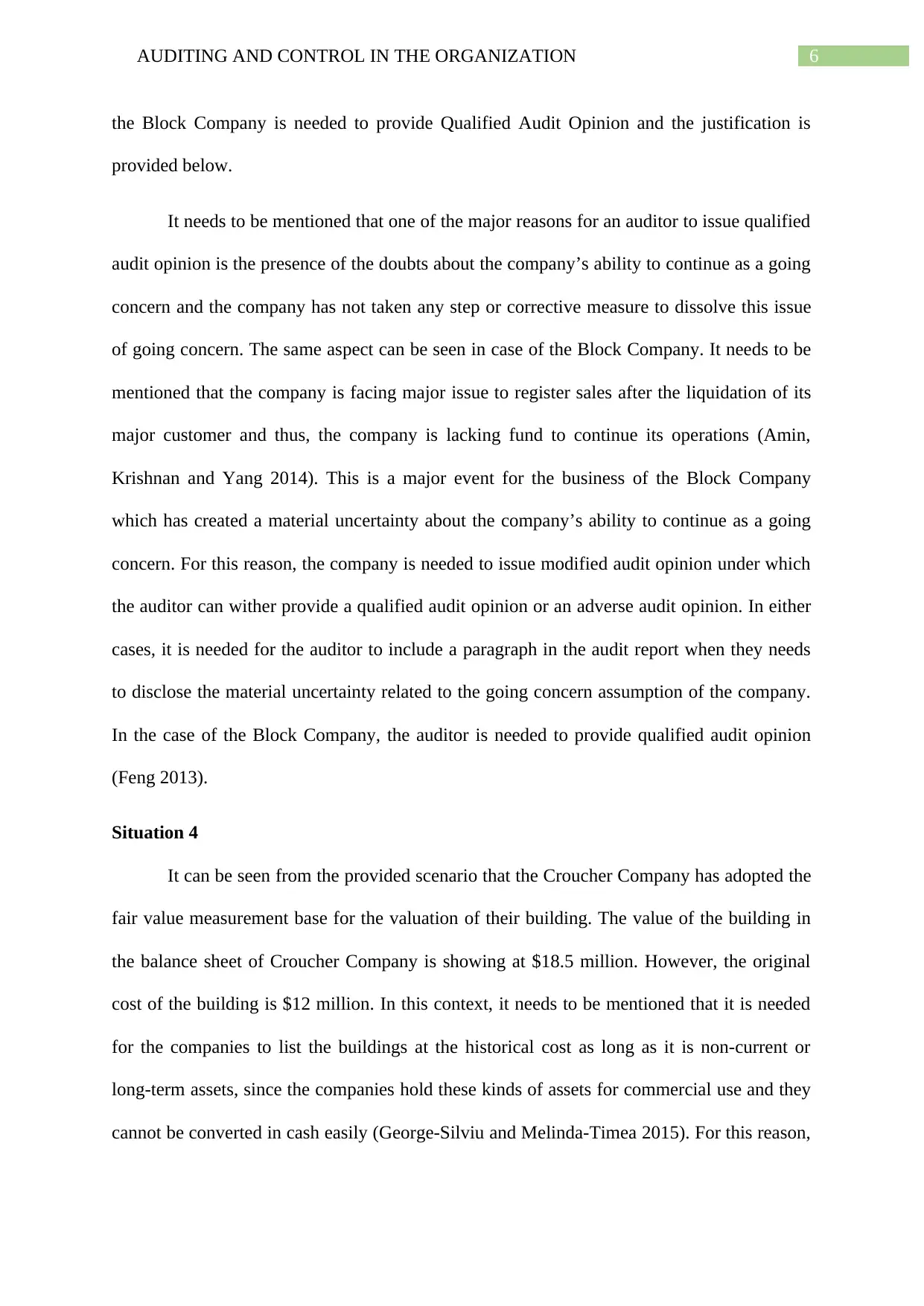
6AUDITING AND CONTROL IN THE ORGANIZATION
the Block Company is needed to provide Qualified Audit Opinion and the justification is
provided below.
It needs to be mentioned that one of the major reasons for an auditor to issue qualified
audit opinion is the presence of the doubts about the company’s ability to continue as a going
concern and the company has not taken any step or corrective measure to dissolve this issue
of going concern. The same aspect can be seen in case of the Block Company. It needs to be
mentioned that the company is facing major issue to register sales after the liquidation of its
major customer and thus, the company is lacking fund to continue its operations (Amin,
Krishnan and Yang 2014). This is a major event for the business of the Block Company
which has created a material uncertainty about the company’s ability to continue as a going
concern. For this reason, the company is needed to issue modified audit opinion under which
the auditor can wither provide a qualified audit opinion or an adverse audit opinion. In either
cases, it is needed for the auditor to include a paragraph in the audit report when they needs
to disclose the material uncertainty related to the going concern assumption of the company.
In the case of the Block Company, the auditor is needed to provide qualified audit opinion
(Feng 2013).
Situation 4
It can be seen from the provided scenario that the Croucher Company has adopted the
fair value measurement base for the valuation of their building. The value of the building in
the balance sheet of Croucher Company is showing at $18.5 million. However, the original
cost of the building is $12 million. In this context, it needs to be mentioned that it is needed
for the companies to list the buildings at the historical cost as long as it is non-current or
long-term assets, since the companies hold these kinds of assets for commercial use and they
cannot be converted in cash easily (George-Silviu and Melinda-Timea 2015). For this reason,
the Block Company is needed to provide Qualified Audit Opinion and the justification is
provided below.
It needs to be mentioned that one of the major reasons for an auditor to issue qualified
audit opinion is the presence of the doubts about the company’s ability to continue as a going
concern and the company has not taken any step or corrective measure to dissolve this issue
of going concern. The same aspect can be seen in case of the Block Company. It needs to be
mentioned that the company is facing major issue to register sales after the liquidation of its
major customer and thus, the company is lacking fund to continue its operations (Amin,
Krishnan and Yang 2014). This is a major event for the business of the Block Company
which has created a material uncertainty about the company’s ability to continue as a going
concern. For this reason, the company is needed to issue modified audit opinion under which
the auditor can wither provide a qualified audit opinion or an adverse audit opinion. In either
cases, it is needed for the auditor to include a paragraph in the audit report when they needs
to disclose the material uncertainty related to the going concern assumption of the company.
In the case of the Block Company, the auditor is needed to provide qualified audit opinion
(Feng 2013).
Situation 4
It can be seen from the provided scenario that the Croucher Company has adopted the
fair value measurement base for the valuation of their building. The value of the building in
the balance sheet of Croucher Company is showing at $18.5 million. However, the original
cost of the building is $12 million. In this context, it needs to be mentioned that it is needed
for the companies to list the buildings at the historical cost as long as it is non-current or
long-term assets, since the companies hold these kinds of assets for commercial use and they
cannot be converted in cash easily (George-Silviu and Melinda-Timea 2015). For this reason,
Paraphrase This Document
Need a fresh take? Get an instant paraphrase of this document with our AI Paraphraser
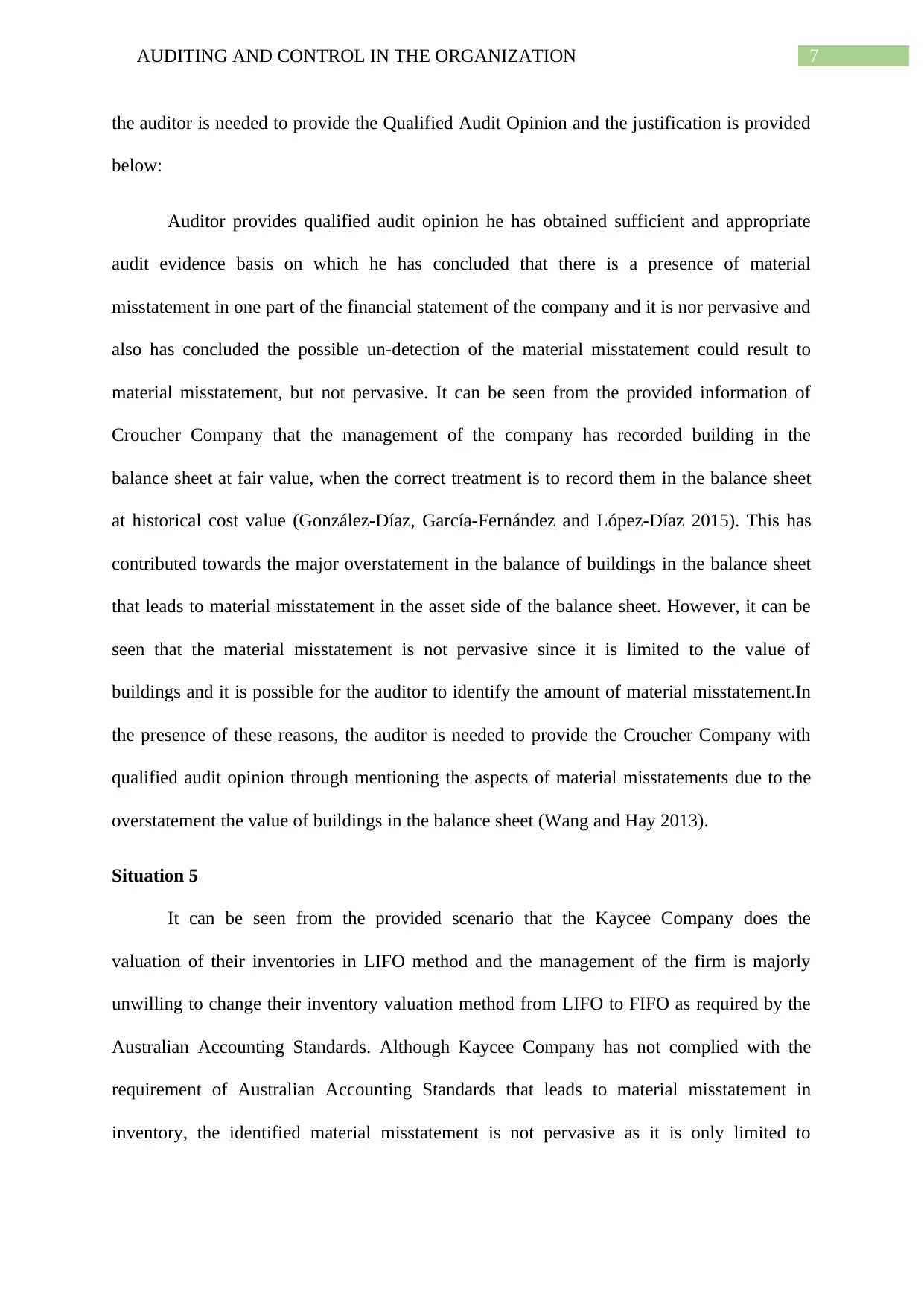
7AUDITING AND CONTROL IN THE ORGANIZATION
the auditor is needed to provide the Qualified Audit Opinion and the justification is provided
below:
Auditor provides qualified audit opinion he has obtained sufficient and appropriate
audit evidence basis on which he has concluded that there is a presence of material
misstatement in one part of the financial statement of the company and it is nor pervasive and
also has concluded the possible un-detection of the material misstatement could result to
material misstatement, but not pervasive. It can be seen from the provided information of
Croucher Company that the management of the company has recorded building in the
balance sheet at fair value, when the correct treatment is to record them in the balance sheet
at historical cost value (González-Díaz, García-Fernández and López-Díaz 2015). This has
contributed towards the major overstatement in the balance of buildings in the balance sheet
that leads to material misstatement in the asset side of the balance sheet. However, it can be
seen that the material misstatement is not pervasive since it is limited to the value of
buildings and it is possible for the auditor to identify the amount of material misstatement.In
the presence of these reasons, the auditor is needed to provide the Croucher Company with
qualified audit opinion through mentioning the aspects of material misstatements due to the
overstatement the value of buildings in the balance sheet (Wang and Hay 2013).
Situation 5
It can be seen from the provided scenario that the Kaycee Company does the
valuation of their inventories in LIFO method and the management of the firm is majorly
unwilling to change their inventory valuation method from LIFO to FIFO as required by the
Australian Accounting Standards. Although Kaycee Company has not complied with the
requirement of Australian Accounting Standards that leads to material misstatement in
inventory, the identified material misstatement is not pervasive as it is only limited to
the auditor is needed to provide the Qualified Audit Opinion and the justification is provided
below:
Auditor provides qualified audit opinion he has obtained sufficient and appropriate
audit evidence basis on which he has concluded that there is a presence of material
misstatement in one part of the financial statement of the company and it is nor pervasive and
also has concluded the possible un-detection of the material misstatement could result to
material misstatement, but not pervasive. It can be seen from the provided information of
Croucher Company that the management of the company has recorded building in the
balance sheet at fair value, when the correct treatment is to record them in the balance sheet
at historical cost value (González-Díaz, García-Fernández and López-Díaz 2015). This has
contributed towards the major overstatement in the balance of buildings in the balance sheet
that leads to material misstatement in the asset side of the balance sheet. However, it can be
seen that the material misstatement is not pervasive since it is limited to the value of
buildings and it is possible for the auditor to identify the amount of material misstatement.In
the presence of these reasons, the auditor is needed to provide the Croucher Company with
qualified audit opinion through mentioning the aspects of material misstatements due to the
overstatement the value of buildings in the balance sheet (Wang and Hay 2013).
Situation 5
It can be seen from the provided scenario that the Kaycee Company does the
valuation of their inventories in LIFO method and the management of the firm is majorly
unwilling to change their inventory valuation method from LIFO to FIFO as required by the
Australian Accounting Standards. Although Kaycee Company has not complied with the
requirement of Australian Accounting Standards that leads to material misstatement in
inventory, the identified material misstatement is not pervasive as it is only limited to
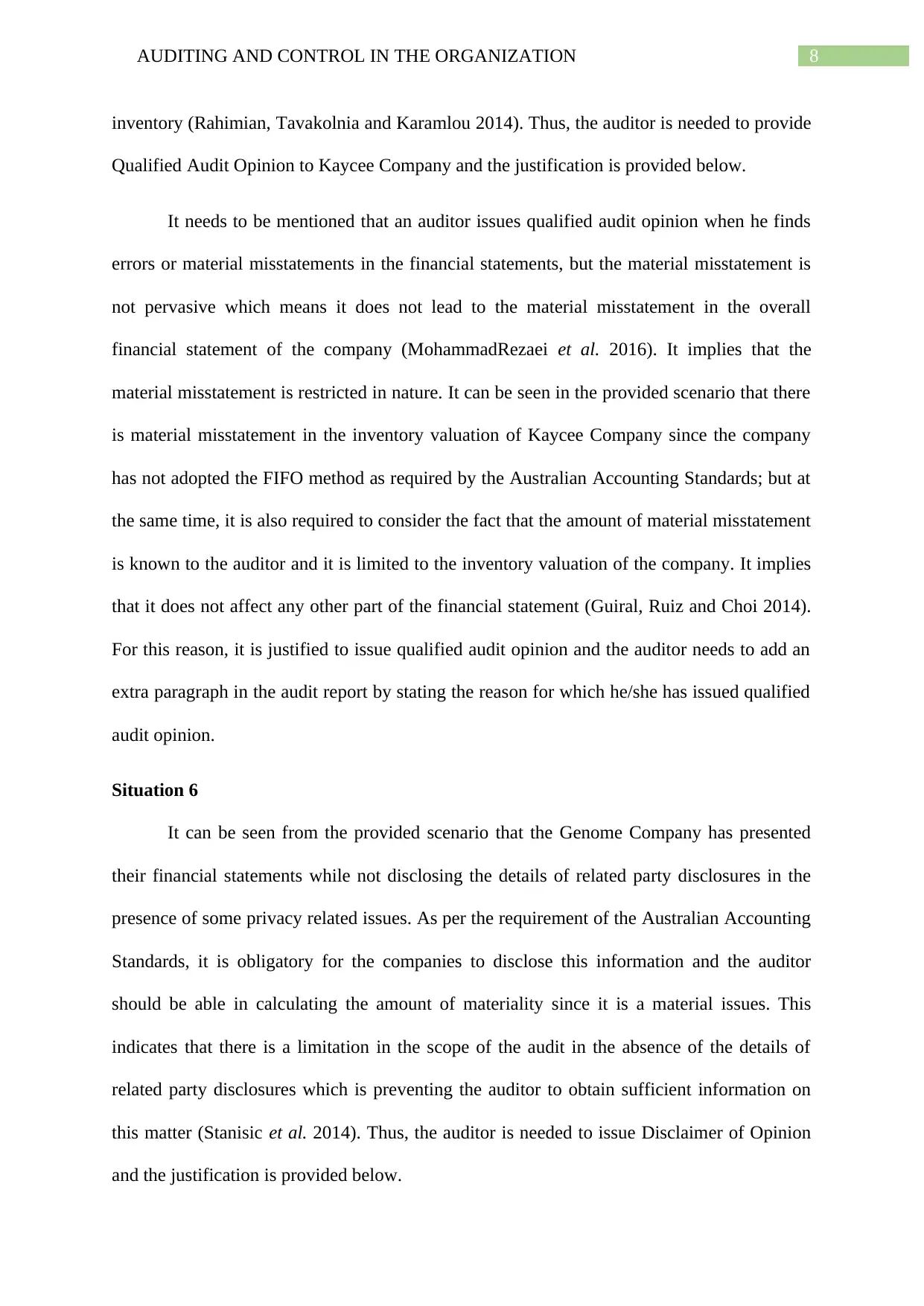
8AUDITING AND CONTROL IN THE ORGANIZATION
inventory (Rahimian, Tavakolnia and Karamlou 2014). Thus, the auditor is needed to provide
Qualified Audit Opinion to Kaycee Company and the justification is provided below.
It needs to be mentioned that an auditor issues qualified audit opinion when he finds
errors or material misstatements in the financial statements, but the material misstatement is
not pervasive which means it does not lead to the material misstatement in the overall
financial statement of the company (MohammadRezaei et al. 2016). It implies that the
material misstatement is restricted in nature. It can be seen in the provided scenario that there
is material misstatement in the inventory valuation of Kaycee Company since the company
has not adopted the FIFO method as required by the Australian Accounting Standards; but at
the same time, it is also required to consider the fact that the amount of material misstatement
is known to the auditor and it is limited to the inventory valuation of the company. It implies
that it does not affect any other part of the financial statement (Guiral, Ruiz and Choi 2014).
For this reason, it is justified to issue qualified audit opinion and the auditor needs to add an
extra paragraph in the audit report by stating the reason for which he/she has issued qualified
audit opinion.
Situation 6
It can be seen from the provided scenario that the Genome Company has presented
their financial statements while not disclosing the details of related party disclosures in the
presence of some privacy related issues. As per the requirement of the Australian Accounting
Standards, it is obligatory for the companies to disclose this information and the auditor
should be able in calculating the amount of materiality since it is a material issues. This
indicates that there is a limitation in the scope of the audit in the absence of the details of
related party disclosures which is preventing the auditor to obtain sufficient information on
this matter (Stanisic et al. 2014). Thus, the auditor is needed to issue Disclaimer of Opinion
and the justification is provided below.
inventory (Rahimian, Tavakolnia and Karamlou 2014). Thus, the auditor is needed to provide
Qualified Audit Opinion to Kaycee Company and the justification is provided below.
It needs to be mentioned that an auditor issues qualified audit opinion when he finds
errors or material misstatements in the financial statements, but the material misstatement is
not pervasive which means it does not lead to the material misstatement in the overall
financial statement of the company (MohammadRezaei et al. 2016). It implies that the
material misstatement is restricted in nature. It can be seen in the provided scenario that there
is material misstatement in the inventory valuation of Kaycee Company since the company
has not adopted the FIFO method as required by the Australian Accounting Standards; but at
the same time, it is also required to consider the fact that the amount of material misstatement
is known to the auditor and it is limited to the inventory valuation of the company. It implies
that it does not affect any other part of the financial statement (Guiral, Ruiz and Choi 2014).
For this reason, it is justified to issue qualified audit opinion and the auditor needs to add an
extra paragraph in the audit report by stating the reason for which he/she has issued qualified
audit opinion.
Situation 6
It can be seen from the provided scenario that the Genome Company has presented
their financial statements while not disclosing the details of related party disclosures in the
presence of some privacy related issues. As per the requirement of the Australian Accounting
Standards, it is obligatory for the companies to disclose this information and the auditor
should be able in calculating the amount of materiality since it is a material issues. This
indicates that there is a limitation in the scope of the audit in the absence of the details of
related party disclosures which is preventing the auditor to obtain sufficient information on
this matter (Stanisic et al. 2014). Thus, the auditor is needed to issue Disclaimer of Opinion
and the justification is provided below.
⊘ This is a preview!⊘
Do you want full access?
Subscribe today to unlock all pages.

Trusted by 1+ million students worldwide
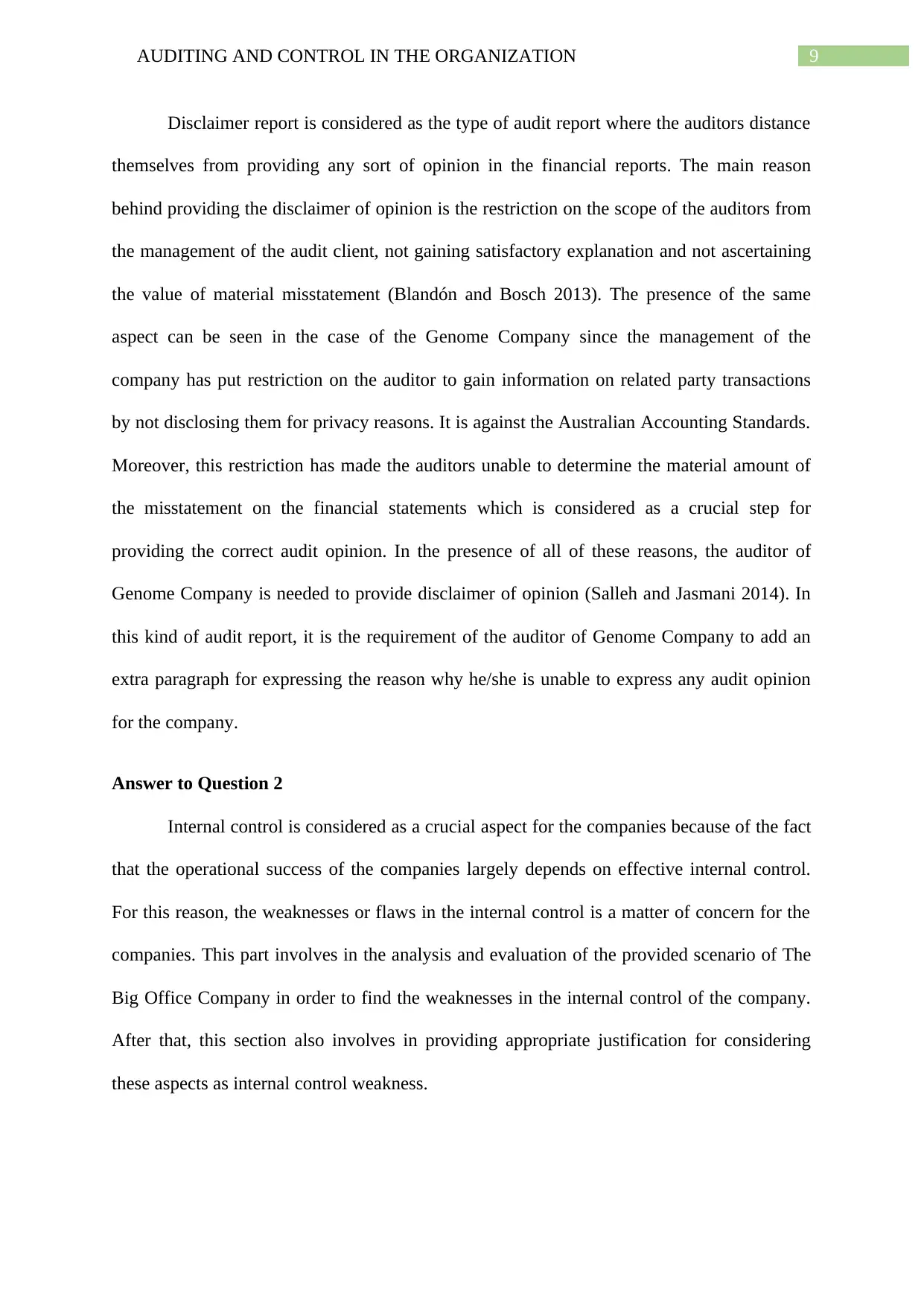
9AUDITING AND CONTROL IN THE ORGANIZATION
Disclaimer report is considered as the type of audit report where the auditors distance
themselves from providing any sort of opinion in the financial reports. The main reason
behind providing the disclaimer of opinion is the restriction on the scope of the auditors from
the management of the audit client, not gaining satisfactory explanation and not ascertaining
the value of material misstatement (Blandón and Bosch 2013). The presence of the same
aspect can be seen in the case of the Genome Company since the management of the
company has put restriction on the auditor to gain information on related party transactions
by not disclosing them for privacy reasons. It is against the Australian Accounting Standards.
Moreover, this restriction has made the auditors unable to determine the material amount of
the misstatement on the financial statements which is considered as a crucial step for
providing the correct audit opinion. In the presence of all of these reasons, the auditor of
Genome Company is needed to provide disclaimer of opinion (Salleh and Jasmani 2014). In
this kind of audit report, it is the requirement of the auditor of Genome Company to add an
extra paragraph for expressing the reason why he/she is unable to express any audit opinion
for the company.
Answer to Question 2
Internal control is considered as a crucial aspect for the companies because of the fact
that the operational success of the companies largely depends on effective internal control.
For this reason, the weaknesses or flaws in the internal control is a matter of concern for the
companies. This part involves in the analysis and evaluation of the provided scenario of The
Big Office Company in order to find the weaknesses in the internal control of the company.
After that, this section also involves in providing appropriate justification for considering
these aspects as internal control weakness.
Disclaimer report is considered as the type of audit report where the auditors distance
themselves from providing any sort of opinion in the financial reports. The main reason
behind providing the disclaimer of opinion is the restriction on the scope of the auditors from
the management of the audit client, not gaining satisfactory explanation and not ascertaining
the value of material misstatement (Blandón and Bosch 2013). The presence of the same
aspect can be seen in the case of the Genome Company since the management of the
company has put restriction on the auditor to gain information on related party transactions
by not disclosing them for privacy reasons. It is against the Australian Accounting Standards.
Moreover, this restriction has made the auditors unable to determine the material amount of
the misstatement on the financial statements which is considered as a crucial step for
providing the correct audit opinion. In the presence of all of these reasons, the auditor of
Genome Company is needed to provide disclaimer of opinion (Salleh and Jasmani 2014). In
this kind of audit report, it is the requirement of the auditor of Genome Company to add an
extra paragraph for expressing the reason why he/she is unable to express any audit opinion
for the company.
Answer to Question 2
Internal control is considered as a crucial aspect for the companies because of the fact
that the operational success of the companies largely depends on effective internal control.
For this reason, the weaknesses or flaws in the internal control is a matter of concern for the
companies. This part involves in the analysis and evaluation of the provided scenario of The
Big Office Company in order to find the weaknesses in the internal control of the company.
After that, this section also involves in providing appropriate justification for considering
these aspects as internal control weakness.
Paraphrase This Document
Need a fresh take? Get an instant paraphrase of this document with our AI Paraphraser
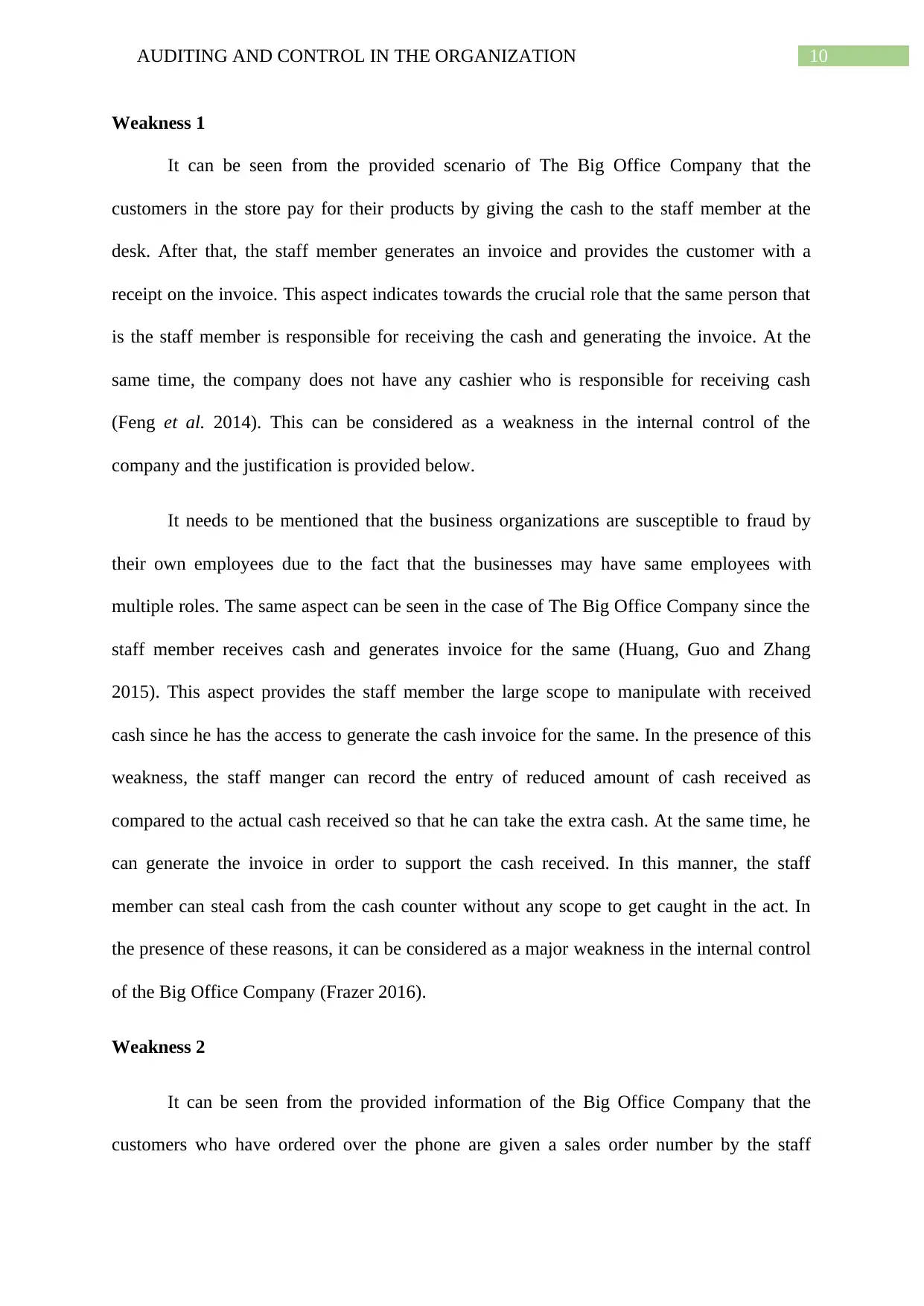
10AUDITING AND CONTROL IN THE ORGANIZATION
Weakness 1
It can be seen from the provided scenario of The Big Office Company that the
customers in the store pay for their products by giving the cash to the staff member at the
desk. After that, the staff member generates an invoice and provides the customer with a
receipt on the invoice. This aspect indicates towards the crucial role that the same person that
is the staff member is responsible for receiving the cash and generating the invoice. At the
same time, the company does not have any cashier who is responsible for receiving cash
(Feng et al. 2014). This can be considered as a weakness in the internal control of the
company and the justification is provided below.
It needs to be mentioned that the business organizations are susceptible to fraud by
their own employees due to the fact that the businesses may have same employees with
multiple roles. The same aspect can be seen in the case of The Big Office Company since the
staff member receives cash and generates invoice for the same (Huang, Guo and Zhang
2015). This aspect provides the staff member the large scope to manipulate with received
cash since he has the access to generate the cash invoice for the same. In the presence of this
weakness, the staff manger can record the entry of reduced amount of cash received as
compared to the actual cash received so that he can take the extra cash. At the same time, he
can generate the invoice in order to support the cash received. In this manner, the staff
member can steal cash from the cash counter without any scope to get caught in the act. In
the presence of these reasons, it can be considered as a major weakness in the internal control
of the Big Office Company (Frazer 2016).
Weakness 2
It can be seen from the provided information of the Big Office Company that the
customers who have ordered over the phone are given a sales order number by the staff
Weakness 1
It can be seen from the provided scenario of The Big Office Company that the
customers in the store pay for their products by giving the cash to the staff member at the
desk. After that, the staff member generates an invoice and provides the customer with a
receipt on the invoice. This aspect indicates towards the crucial role that the same person that
is the staff member is responsible for receiving the cash and generating the invoice. At the
same time, the company does not have any cashier who is responsible for receiving cash
(Feng et al. 2014). This can be considered as a weakness in the internal control of the
company and the justification is provided below.
It needs to be mentioned that the business organizations are susceptible to fraud by
their own employees due to the fact that the businesses may have same employees with
multiple roles. The same aspect can be seen in the case of The Big Office Company since the
staff member receives cash and generates invoice for the same (Huang, Guo and Zhang
2015). This aspect provides the staff member the large scope to manipulate with received
cash since he has the access to generate the cash invoice for the same. In the presence of this
weakness, the staff manger can record the entry of reduced amount of cash received as
compared to the actual cash received so that he can take the extra cash. At the same time, he
can generate the invoice in order to support the cash received. In this manner, the staff
member can steal cash from the cash counter without any scope to get caught in the act. In
the presence of these reasons, it can be considered as a major weakness in the internal control
of the Big Office Company (Frazer 2016).
Weakness 2
It can be seen from the provided information of the Big Office Company that the
customers who have ordered over the phone are given a sales order number by the staff
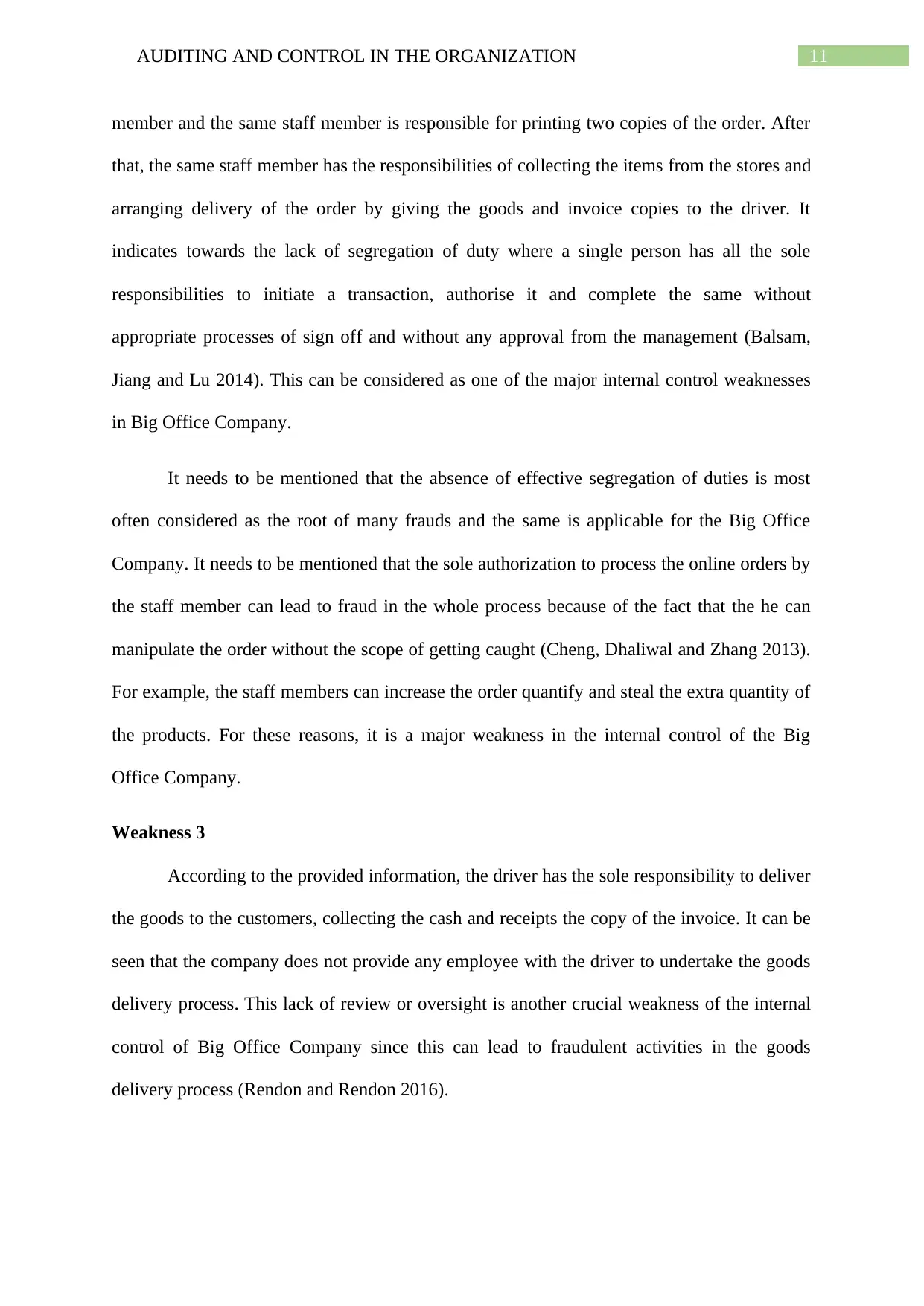
11AUDITING AND CONTROL IN THE ORGANIZATION
member and the same staff member is responsible for printing two copies of the order. After
that, the same staff member has the responsibilities of collecting the items from the stores and
arranging delivery of the order by giving the goods and invoice copies to the driver. It
indicates towards the lack of segregation of duty where a single person has all the sole
responsibilities to initiate a transaction, authorise it and complete the same without
appropriate processes of sign off and without any approval from the management (Balsam,
Jiang and Lu 2014). This can be considered as one of the major internal control weaknesses
in Big Office Company.
It needs to be mentioned that the absence of effective segregation of duties is most
often considered as the root of many frauds and the same is applicable for the Big Office
Company. It needs to be mentioned that the sole authorization to process the online orders by
the staff member can lead to fraud in the whole process because of the fact that the he can
manipulate the order without the scope of getting caught (Cheng, Dhaliwal and Zhang 2013).
For example, the staff members can increase the order quantify and steal the extra quantity of
the products. For these reasons, it is a major weakness in the internal control of the Big
Office Company.
Weakness 3
According to the provided information, the driver has the sole responsibility to deliver
the goods to the customers, collecting the cash and receipts the copy of the invoice. It can be
seen that the company does not provide any employee with the driver to undertake the goods
delivery process. This lack of review or oversight is another crucial weakness of the internal
control of Big Office Company since this can lead to fraudulent activities in the goods
delivery process (Rendon and Rendon 2016).
member and the same staff member is responsible for printing two copies of the order. After
that, the same staff member has the responsibilities of collecting the items from the stores and
arranging delivery of the order by giving the goods and invoice copies to the driver. It
indicates towards the lack of segregation of duty where a single person has all the sole
responsibilities to initiate a transaction, authorise it and complete the same without
appropriate processes of sign off and without any approval from the management (Balsam,
Jiang and Lu 2014). This can be considered as one of the major internal control weaknesses
in Big Office Company.
It needs to be mentioned that the absence of effective segregation of duties is most
often considered as the root of many frauds and the same is applicable for the Big Office
Company. It needs to be mentioned that the sole authorization to process the online orders by
the staff member can lead to fraud in the whole process because of the fact that the he can
manipulate the order without the scope of getting caught (Cheng, Dhaliwal and Zhang 2013).
For example, the staff members can increase the order quantify and steal the extra quantity of
the products. For these reasons, it is a major weakness in the internal control of the Big
Office Company.
Weakness 3
According to the provided information, the driver has the sole responsibility to deliver
the goods to the customers, collecting the cash and receipts the copy of the invoice. It can be
seen that the company does not provide any employee with the driver to undertake the goods
delivery process. This lack of review or oversight is another crucial weakness of the internal
control of Big Office Company since this can lead to fraudulent activities in the goods
delivery process (Rendon and Rendon 2016).
⊘ This is a preview!⊘
Do you want full access?
Subscribe today to unlock all pages.

Trusted by 1+ million students worldwide
1 out of 22
Related Documents
Your All-in-One AI-Powered Toolkit for Academic Success.
+13062052269
info@desklib.com
Available 24*7 on WhatsApp / Email
![[object Object]](/_next/static/media/star-bottom.7253800d.svg)
Unlock your academic potential
Copyright © 2020–2025 A2Z Services. All Rights Reserved. Developed and managed by ZUCOL.





